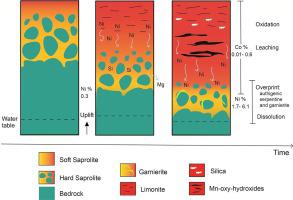当前位置:
X-MOL 学术
›
Ore Geol. Rev.
›
论文详情
Our official English website, www.x-mol.net, welcomes your
feedback! (Note: you will need to create a separate account there.)
Mineralogy and geochemistry of the Berong Ni-Co laterite deposit, Palawan, Philippines
Ore Geology Reviews ( IF 3.2 ) Pub Date : 2020-10-01 , DOI: 10.1016/j.oregeorev.2020.103686 Carmela Alen J. Tupaz , Yasushi Watanabe , Kenzo Sanematsu , Takuya Echigo
Ore Geology Reviews ( IF 3.2 ) Pub Date : 2020-10-01 , DOI: 10.1016/j.oregeorev.2020.103686 Carmela Alen J. Tupaz , Yasushi Watanabe , Kenzo Sanematsu , Takuya Echigo

|
Abstract Intense weathering of the serpentinized peridotite resulted in the formation of the Berong Ni-Co laterite deposit in Palawan (Philippines). The studied laterite profiles are divided from base to top into: (i) serpentinized bedrock, (ii) saprolite horizon, and (iii) limonite horizon. Olivine in the peridotite contains a significant amount of Ni (average 0.38 wt% NiO), thus representing the main source of the ore in the laterite horizons. Six types of Ni-bearing serpentines (up to 6.65 wt% NiO) in the saprock are discriminated based on their textures and Raman signatures. Garnierite (a mixture of serpentine-, kerolite- and sepiolite-like clays) typically occurs as coatings or fracture fillings in the saprock and is characterized by strikingly high NiO content up to 34.86 wt%. Goethite and Mn-oxy-hydroxides (i.e. lithiophorite-asbolane intermediates) are the principal hosts of Ni in the limonite (up to 2.15 wt% NiO and 23.89 wt% NiO, respectively) with the latter also being the main Co carriers (up to 12.59 wt% CoO). The whole-rock XRF data show typical trends observed in other Ni laterite deposits, where Mg and Si are depleted toward the surface, and the transition metals (i.e. Fe, Al, Ni, Co, and Mn) are retained in the weathered horizons. The saprolite horizon is particularly enriched in Ni, while the lower section of the limonite horizon is enriched in Co. The mildly acidic environmental condition (pH ≤ 6.57) in the limonite horizon was found to enhance the mobilization and re-distribution of Ni from the limonite towards the lower section of the profiles. Geological observations, coupled with mineralogical and geochemical data, show that the Berong Ni-Co laterite deposit formed in two weathering processes: (i) development of the saprolite and the limonite horizons, and (ii) late precipitation of secondary phyllosilicates (i.e. garnierite), Mn-oxy-hydroxides and silica.
中文翻译:

菲律宾巴拉望 Berong Ni-Co 红土矿床的矿物学和地球化学
摘要 蛇纹石化橄榄岩的强烈风化导致巴拉望(菲律宾)贝龙镍钴红土矿床的形成。研究的红土剖面从底部到顶部分为:(i)蛇纹石化基岩,(ii)腐泥土层,和(iii)褐铁矿层。橄榄岩中的橄榄石含有大量 Ni(平均 0.38 wt% NiO),因此代表了红土层中矿石的主要来源。根据其质地和拉曼特征,可以区分出土岩中六种类型的含镍蛇纹石(高达 6.65 wt% NiO)。石榴石(蛇纹石、角纹石和海泡石状粘土的混合物)通常作为边岩中的涂层或裂缝填充物出现,其特征是 NiO 含量高达 34.86 wt%。针铁矿和锰羟基氧化物(即 锂硫磷石-asbolane 中间体)是褐铁矿中 Ni 的主要主体(分别高达 2.15 wt% NiO 和 23.89 wt% NiO),后者也是主要的 Co 载体(高达 12.59 wt% CoO)。全岩 XRF 数据显示了在其他 Ni 红土矿床中观察到的典型趋势,其中 Mg 和 Si 向地表耗尽,过渡金属(即 Fe、Al、Ni、Co 和 Mn)保留在风化层中。腐泥土层特别富含 Ni,而褐铁矿层的下部富含 Co。发现褐铁矿层中的弱酸性环境条件(pH ≤ 6.57)增强了 Ni 的动员和重新分布。褐铁矿朝向型材的下部。地质观测,加上矿物学和地球化学数据,
更新日期:2020-10-01
中文翻译:

菲律宾巴拉望 Berong Ni-Co 红土矿床的矿物学和地球化学
摘要 蛇纹石化橄榄岩的强烈风化导致巴拉望(菲律宾)贝龙镍钴红土矿床的形成。研究的红土剖面从底部到顶部分为:(i)蛇纹石化基岩,(ii)腐泥土层,和(iii)褐铁矿层。橄榄岩中的橄榄石含有大量 Ni(平均 0.38 wt% NiO),因此代表了红土层中矿石的主要来源。根据其质地和拉曼特征,可以区分出土岩中六种类型的含镍蛇纹石(高达 6.65 wt% NiO)。石榴石(蛇纹石、角纹石和海泡石状粘土的混合物)通常作为边岩中的涂层或裂缝填充物出现,其特征是 NiO 含量高达 34.86 wt%。针铁矿和锰羟基氧化物(即 锂硫磷石-asbolane 中间体)是褐铁矿中 Ni 的主要主体(分别高达 2.15 wt% NiO 和 23.89 wt% NiO),后者也是主要的 Co 载体(高达 12.59 wt% CoO)。全岩 XRF 数据显示了在其他 Ni 红土矿床中观察到的典型趋势,其中 Mg 和 Si 向地表耗尽,过渡金属(即 Fe、Al、Ni、Co 和 Mn)保留在风化层中。腐泥土层特别富含 Ni,而褐铁矿层的下部富含 Co。发现褐铁矿层中的弱酸性环境条件(pH ≤ 6.57)增强了 Ni 的动员和重新分布。褐铁矿朝向型材的下部。地质观测,加上矿物学和地球化学数据,











































 京公网安备 11010802027423号
京公网安备 11010802027423号